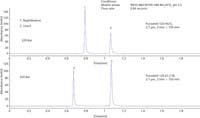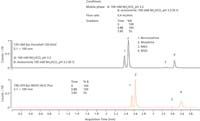Hydrophillic Interaction Chromatography (HILIC) Using Poroshell 120 HILIC
Agilent Technologies
Introduction
HILIC retention on a silica-based column is believed to involve a combination of mechanisms. First, a water layer must be adsorbed onto the polar silica surface, creating a liquid-liquid extraction system. The polar analytes can then partition into and out of this adsorbed water layer, with more polar analytes having a stronger interaction with this immobilized water layer. Charged polar analytes can also undergo ion exchange with the charged silica. Elution is typically from least to most polar: the opposite of reversed-phase liquid chromaography (RPLC). For HILIC method development it is important to remember that the solvent strengths are different than in RPLC. For HILIC mode, solvent strength is tetrahydrofuran < acetone < acetonitrile < isopropanol < ethanol < methanol < water, with water being the strongest solvent (1,2).
The development of superficially porous particles has led to the possibilities of method transfer from larger 5 and 3.5 µm particles and from smaller 1.8 µm particles. HILIC mobile phases possess much lower viscosities and so generate lower back pressure. These columns still possess the advantage of robustness in sample preparation, as they have the same 2 µm frit used with larger columns. They deliver nearly the same efficiency as the sub-2 µm columns with better robustness. In a previously published note, several applications of HILIC are transferred from totally porous columns (ZORBAX Rx-Sil, 5 µm, or ZORBAX RRHD HILIC Plus,1.8 µm) to superficially porous Poroshell 120 HILIC columns (5).
Experimental
Two systems were used in this application note, an Agilent 1200 SL with a diode array detector and an Agilent 1290 Infinity LC System with an Agilent 6410A Triple Quadrupole Mass Spectrometer. The setup on the MS-equipped system was optimized for lowest possible extra-column volume with short 0.075 mm i.d. capillaries found in the Agilent Ultra Low Dispersion Kit (p/n 5067-5189) and with an Agilent LC System Rack (p/n 5001-3726). The 1200 SL system was configured with the shortest possible 0.012 mm i.d. tubing; delay volume was reduced by removing the pulse damper and mixing column, and by using the automatic delay volume reduction (ADVR) for gradient analyses (3).
Columns
- Agilent ZORBAX RRHD HILIC Plus, 2.1 × 100 mm, 1.8 µm (959758-901)
- Poroshell 120 HILIC, 2.1 × 100 mm, 2.7 µm ( 695775901)
- Poroshell 120 HILIC, 3 × 150 mm, 2.7 µm ( 693975301)
- Poroshell 120 EC-C18, 3 × 150 mm, 2.7 µm (693975302)
Results and Discussion
In Figure 1, a sample containing a polar analyte, uracil and a nonpolar analyte, naphthalene, is analysed on a Poroshell 120 ECC18 column and a Poroshell 120 HILIC column. See the elution order is reversed. On the HILIC column the uracil, a difficult compound to retain, is strongly retained.

Figure 1: Comparison of HILIC versus reversed-phase LC on Poroshell 120 2.7 µm columns using the same mobile phase 90/10 MeCN/100 mM NH4HC02H.
Figure 2 shows a gradient separation of morphine and its metabolites separated on both Poroshell 120 HILIC and Agilent ZORBAX RRHD HILIC Plus (5). Several advantages have been shown in using the HILIC separation in MS detection. A four-fold increase in sensitivity with HILIC mode is produced due to more efficient spraying and desolvation in the electrospray ionization mass spectrometry ESIMS source as compared to RPLC. This generates less baseline noise and a more intense MS signal.

Figure 2: Morphine and metabolite separation on Poroshell 120 HILIC 2.7 µm and ZORBAX RRHD HILIC Plus 1.8 µm.
As can be seen in Figure 2, the elution order and selectivity of the compounds is the same on the superficially porous and totally porous columns. At this flow rate, this method can be run on a wide variety of instruments. The 0.075 mm i.d. tubing from the low dispersion kit allows easy connection to the mass spectrometer with minimal peak dispersion. In reverse phase mode with its high aqueous content, this may be more of a problem due to high pressure caused by highly viscous solvents, limiting the analysis to only UHPLC systems.
When coupled to reversed-phase SPE or other sample prep that would present the sample in acetonitrile, less work needs to be carried out as a HILIC method could be injected with little or no aqueous dilution.
Conclusions
Elution of polar and non-polar compounds is typically reversed on Poroshell 120 HILIC as compared to Poroshell 120 EC-C18. Poroshell 120 HILIC is similar to Rx-Sil and ZORBAX RRHD HILIC Plus for many applications. Poroshell 120 HILIC is ideal for MS applications, especially when low dispersion tubing is used. The extra pressure generated by the tubing may be offset by the lower pressure of the Poroshell 120 2.7 µm particle as compared to sub2 µm particle. Poroshell 120 HILIC yields similar efficiencies to sub-2 µm totally porous RRHD HILIC Plus, and may prove to be more robust in situations with moderately dirty samples, due to a larger frit at the inlet of the Poroshell 120 column.
For more details and additional discussion, see the full application note, publication 5991-1242EN.
References
(1) D.V. McCalley, J. Chromatography A, 1217, 3408 (2010).
(2) Transfer of Methods between Poroshell 120 EC-C18 and Zorbax Eclipse Plus C18, Technical Overview, Agilent Technologies, Inc. Publication number 5990-6588EN (2011).
(3) A.E. Mack, Optimizing Performance of an Agilent ZORBAX RRHD Eclipse Plus C18 Column by Enhancing an Agilent 1290 Infinity LC System for Ultra-Low Dispersion. Application note, Agilent Technologies, Inc. Publication number 5990-9502EN (2011).
(4) U. Huber, Analysis of Catecholamines by HPLC, Application note, Agilent Technologies, Inc. Publication number 5968-2966EN (1998).
(5) A.E. Mack, Comparing HILIC and RPLC of Morphine using Agilent ZORBAX RRHD Columns with UHPLC/MS Application note, Agilent Technologies, Inc. Publication number 5990-9502EN (2011).
Agilent Technologies Inc.
2850 Centerville Road, Wilmington, Delaware 19808, USA
tel. (800) 227 9770 (Directory) fax (866) 497 1134
Website: www.chem.agilent.com/Library/applications/5991-1242EN.pdf

Assessing Thorium-Peptide Interactions Using Hydrophilic Interaction Liquid Chromatography
February 4th 2025Paris-Saclay University scientists used hydrophilic interaction liquid chromatography (HILIC) coupled to electrospray ionization mass spectrometry (ESI-MS) and inductively coupled plasma mass spectrometry (ICP-MS) to assess thorium’s interaction with peptides.

.png&w=3840&q=75)

.png&w=3840&q=75)



.png&w=3840&q=75)



.png&w=3840&q=75)









